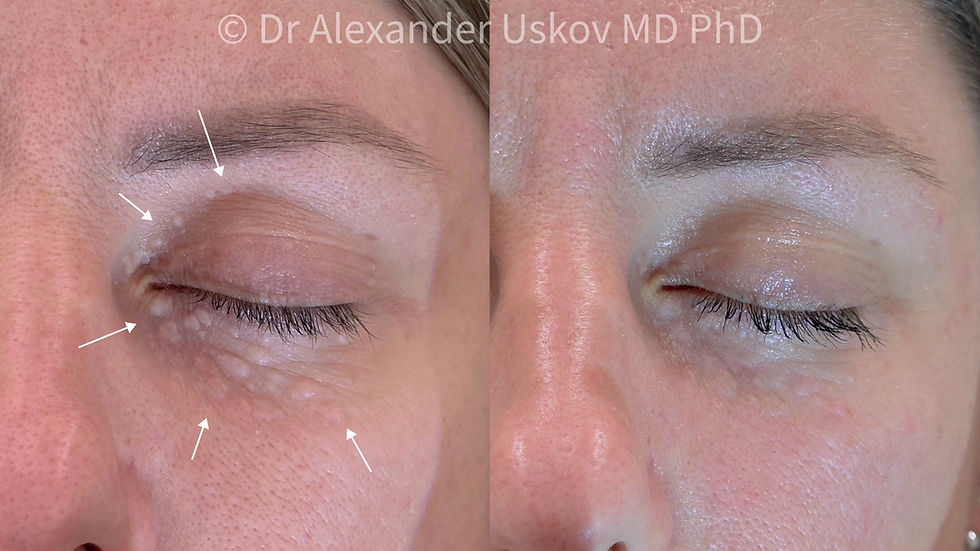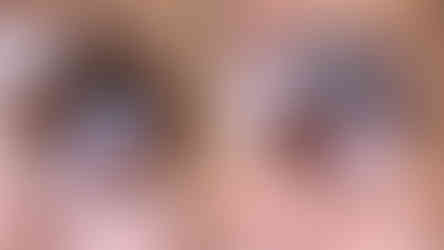Syringoma laser treatment
- gertnulk
- Aug 17
- 3 min read
Aesthetically pleasing and safe solution at Dr. Uskov’s clinic

Syringomas are benign growths that arise from the excretory ducts of eccrine sweat glands. They appear as small, flesh-colored or slightly yellowish nodules, most commonly located on the lower eyelids, cheeks, and forehead, and less frequently on the neck, chest, or abdomen. Although medically harmless, syringomas often cause aesthetic discomfort and lower self-esteem, particularly in women.
At Dr Uskov's clinic, modern laser removal of syringomas is performed using safe technologies and minimally invasive protocols, ensuring minimal risk of complications and excellent cosmetic results.
A relevant problem?
Syringomas most often appear:
In women aged 25–45;
During hormonal changes (puberty, pregnancy, menopause);
With increased sweating;
In individuals with an Asian skin phototype, where there are usually more formations
They can occur as single or multiple formations, appear symmetrically, and may increase in number over time. Attempting removal at home or causing trauma to them can lead to:
Inflammation;
Hyperpigmentation;
Scarring of the syringoma
Why should you use a laser?
Laser removal of syringomas offers several clear advantages:
High precision of action
Minimal skin trauma
Simultaneous coagulation of blood vessels, preventing bleeding
Fast healing with no stitches
Reduced risk of pigmentation and scarring when following doctor’s recommendations
Cosmetically acceptable results, even when removing multiple lesions
The treatment course
1. Consultation and diagnostics
Before the procedure, an in-person assessment is conducted, including:
Visual and instrumental evaluation of the lesion structure
If necessary:
Digital dermatoscopy
Examination with a UV-light
Infrared inspection
Differential diagnosis for milia, xanthelasma, syringomyelia, etc.
Discussion of the patient’s skin characteristics, including susceptibility to hyperpigmentation or scarring
2. Laser removal of the syringomas
Types of lasers: Typically fractional Er:YAG or CO₂, depending on skin phototype, lesion depth, and density
Anesthesia: Local topical anesthetic cream if needed
Duration: 10–20 minutes depending on the number of syringomas
Frequency: In 90% of cases, a single procedure is sufficient; in rare cases, a second session may be required after 6–12 weeks
Factors affecting results
Number and depth of syringomas
Patient’s age and skin regeneration speed
Skin type (Fitzpatrick classification)
Previous attempts at removal
Adherence to post-procedure care instructions
Recovery after the procedure
Immediately after the procedure, mild redness, swelling, or scabbing may appear, which usually resolves within 5–7 days
Recommendations:
Avoid makeup on the treated area for 3–5 days
Avoid sun exposure and use SPF 50+ for at least 4 weeks post procedure
Do not scratch or remove scabs
Apply soothing creams prescribed by the doctor if needed
Full skin recovery and final results appear within 2–4 weeks
Safety at Dr. Uskov’s Clinic
Laser work on the eyelids, face, and neck requires:
High precision and appropriate medical training
Knowledge of skin anatomy and potential risks
Individualized approach for each patient
At our clinic:
We use the latest medical laser systems, including CO₂, Er:YAG, Nd:YAG, and picosecond platforms
Procedures are performed by doctors with international qualifications in laser medicine
Every case is unique
Every patient has unique skin and syringoma characteristics.
For each patient we:
develop a personalized treatment plan
conduct preliminary tests and assess skin reaction
consider recurrence risk, especially with multiple or familial syringomas
support the patient throughout the recovery process
Real before-and-after photos can be viewed in our gallery or at scarsinfo.com











Comments